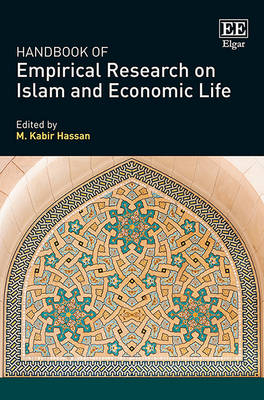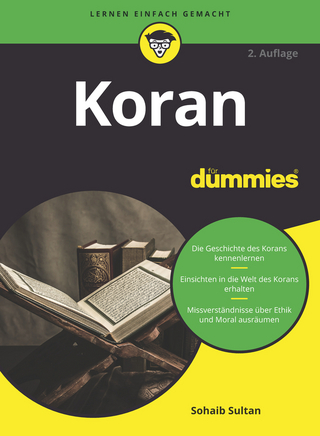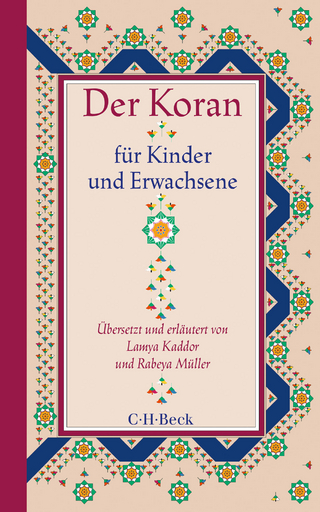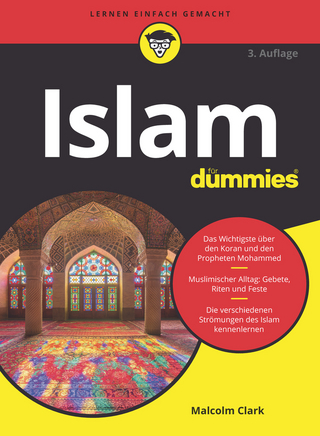
Handbook of Empirical Research on Islam and Economic Life
Edward Elgar Publishing Ltd (Verlag)
978-1-78471-072-9 (ISBN)
Islamic economics and finance has recently enjoyed a spike in interest and a rise in status from theology-tinged discussion fodder for Muslim intellectuals to a fully fledged academic discipline knocking on the doors of university social science departments. The Handbook of Empirical Research on Islam and Economic Life provides a solid background and overview of current empirical research, evaluating how well Islamic institutions have performed in pursuing their objectives. With contributions from leading scholars, this unique Handbook provides chapters examining a range of phenomena in Islamic finance, focusing on five main research areas: religion and growth, Islamic social finance, Islamic banking and finance, Islamic capital market and Sukuk (Islamic bonds). This selection of research literature provides:
a socio-economic profile of Muslim countries
an outline of Islamic systems of accounting and governance
an analysis of the religion-development link
a consideration of the role of the state under Islam.
Scholars of finance and Islam in Muslim and in Western universities, students in graduate and post-graduate courses in Islamic studies, and Islamic research institutes and libraries in Western, Middle Eastern and Asian universities will all find great value in this vital resource and its exploration of a compelling approach to finance.
Contributors include: A.U.F. Ahmad, M.S. Akhtar, E. Aksak, M.A.M. Al JanabiIhsan Isik, N. Alam, F. Alqahtani, S.O. Alhabshi, C. Aloui, S.B. Anceaur, D. Ashraf, M. Asutay, A.F. Aysan, O. Bacha, A. Barajas, M. Bekri, C. De Anca, G. Dewandaru, M. Disli, A.O. El Aloui, M. Farooq, K. Gazdar, R. Grassa, H.B. Hamida, M.K. Hassan, R. Hayat, C.M. Henry, J. Howe, M.H. Ibrahim, M. Jahrom, K. Jouaber-Snoussi, F. Kamarudin, M. Khawaja, H. Khan, K. Khan, O. Krasicka, M.T. Majeed, N.A.K. Malim, M. Masih, A. Massara, D.G. Mayes, A.K.M. Meera, M. Mehri, C. Mertzanis, H.S. Min, M.A. Mobin, Y.A. Nainggolan, M. Naseri, A.M. Nassir, A. Ng, S. Nowak, M.S. Nurzaman, M. Omran, H. Ozturk, M. Rashid, M.E.S.M. Rashid, R.M. Shafi, A. Shah, N.S. Shirazi, F. Sufian, G.M.W. Ullah, P. Verhoeven, L. Weill, S. Zaheer, S.R.S.M. Zain, A. Zarka
Edited by M. Kabir Hassan, Professor of Finance, Department of Economics and Finance, University of New Orleans, US
Contents:
1. Introduction
Part I: Religion and Growth:
1. Social Preferences and Values: An Experimental Analysis for Religiosity
Anwar Shah, Karim Khan and Hayat Khan
2. Openness, Culture, Legal Environment and Islamic Finance
Kaouthar Gazdar, Rihab Grassa and M. Kabir Hassan
3. Islamic Finance in Movement: Public Opinion in the Arab Region
Clement Henry
Part II: Islamic Social Finance:
4. Evaluating The Impact of Zakat by Indicator of Disaggregated Human Development Index: An Empirical Finding
Mohamad Soleh Nurzaman
5. Poverty, Finance and Institutions: Evidence from OIC Countries
Muhammad Tariq Majeed
6. The Social and Cultural Impact on Firms’ Access to Finance in an Islamic Environment
Charilaos Mertzanis
7. Reporting of Zakat and Charitable Activities in Islamic Banks: Theory and Practice in a Multi-cultural Setting
Mamunur Rashid, M. Kabir Hassan, How Shi Min and G.M. Wali Ullah
8. Achieving Sustainable Economic Development through Islamic Microfinance and Potential of proposed Two Tier Mudarabah Waqf Business Model
Mohammad Ashraf Mobin and Abu Umar Faruq Ahmad
9. Can Islamic Banking Increase Financial Inclusion?
Sami Ben Naceur, Adolfo Barajas and Alexander Massara
10. Social tax and transfers for poverty alleviation: A case for low and middle income countries
Nasim Shah Shirazi and Anas Zarka
Part III: Islamic Banking and finance
11. The Impact of the Global Financial Crisis on Islamic Banking
Faisal Alqahtani and David G. Mayes
12. Country Governance and the Performance of Islamic and Conventional Banks: International Evidence
Fadzlan Sufian, M. Kabir Hassan, Fakarudin Kamarudin and Annuar Md. Nassir
13. How Institutions Shape the Gap in Efficiency between Islamic and Conventional Banks
Laurent Weill
14. Differences between Islamic and Conventional Finance in Malaysia
Olga Krasicka and Sylwia Nowak
15. On the Co-existence of Conventional and Islamic Banks: Do These Banks Differ in Business Structure
Sajjad Zaheer and Moazzam Farooq
16. Macroeconomic Shocks and Islamic Bank Behavior in Turkey
Ahmet Faruk Aysan, Mustafa Disli, Adam Ng and Huseyin Ozturk
17. Explaining Intermediation Costs of Islamic Banks in OIC Countries
Nurhafiza Abdul Kader Malim, Mansor H. Ibrahim and Mohamed Eskandar Shah Mohd Rasid
18. Liquidity Risk Management in Emerging and Islamic Markets in Post Financial Crisis in Gulf Cooperation Council
Mazin A.M. Al Janabi
19. How Efficient are the Commercial, Investment and Islamic Bank Managers in Jordan
Ihsan Isik, Mohammed Omran and M. Kabir Hassan
Part IV: Islamic Capital Market
20. Does Islamic investment accrue hedging benefits?
Dawood Ashraf and Mohsin Khawaja
21. Volatility forecasting, value-at-risk and expected shortfall estimations under Basel II accord in GCC Sharia stocks
Chaker Aloui, M. Kabir Hassan and Hela ben Hamida,
22. Do stock returns react to an Islamic label
Raphie Hayat and Celia de Anca
23. Taking a Leap of Faith: Are Investors Left Short Changed?
Yunieta A. Nainggolan, Janice C.Y. How and Peter Verhoeven
24. Quantitative Studies of Islamic and Conventional Assets
Shumi Akhtar and Maria Jahromi
25. Profit-Sharing Ratio as a Screening Device in Venture Capital
Meryem Mehri, Kaouther Jouaber-Snoussi and M. Kabir Hassan
26. On the dependency structure of Islamic assets
Mahmoud Bekri, M. Kabir Hassan and Nafis Alam
27. Malaysian Investors’ perspectives on the integration and Co-movement of Islamic Stock Markets in Developed and Developing Countries
Marjan Naseri, Syed Othman Alhabshi and Mansur Masih
28. A Wavelet approach to time-scale relationships among the Islamic and conventional stock markets and LIBOR
AbdelKader O. el Alaoui, Ginanjar Dewandaru, Obiyathulla Bacha and Mansur Masih
Part V: Sukuk (Islamic Bonds)
29. Testing the Financial Distress Prediction Model for Sukuk-Issuing Companies In Malaysia
Roslina Mohamad Shafi, Sharifah Raihan Syed Mohd Zain, Mohamed Eskandar Shah Mohd Rasid and Ahamed Kameel Mydin Meera
30. The Economic and Political Determinants of Depth and Strength in Sukuk Markets
Mehmet Asutay and Ercument Aksak
Index
| Erscheinungsdatum | 25.01.2017 |
|---|---|
| Verlagsort | Cheltenham |
| Sprache | englisch |
| Maße | 169 x 244 mm |
| Themenwelt | Schulbuch / Wörterbuch ► Lexikon / Chroniken |
| Geisteswissenschaften ► Religion / Theologie ► Islam | |
| Sozialwissenschaften ► Soziologie ► Spezielle Soziologien | |
| Wirtschaft ► Volkswirtschaftslehre ► Finanzwissenschaft | |
| Wirtschaft ► Volkswirtschaftslehre ► Makroökonomie | |
| ISBN-10 | 1-78471-072-5 / 1784710725 |
| ISBN-13 | 978-1-78471-072-9 / 9781784710729 |
| Zustand | Neuware |
| Haben Sie eine Frage zum Produkt? |
aus dem Bereich


